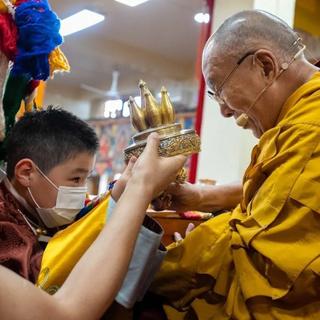


Mongolia's sacred child: The heavy geopolitical responsibility weighing on a 9-year-old boy
ProfileBorn into an influential family in Ulaanbaatar, he is considered by the authorities of a major school of Buddhism to be the reincarnation of a leading religious figure, much to the chagrin of neighboring China.
The monastery's green and yellow roofs stretch west of Ulaanbaatar. With its prayer wheels, dozens of red-robe-wearing monks and immense Buddha of compassion, Gandan is the epicenter of Mongolia's religious life. One evening in 2016, nine children and their fathers were gathered in one of its rooms. On that day, two clerics and an academic spread rosaries, sacred scriptures books and clothes in front of them that previously belonged to the country's highest religious authority, the ninth bogd, who died in 2012 at the age of 79.
One of these babies, a 1.5-year-old boy, stood out by grabbing the revered figure's belongings without hesitation. The academic coordinating the ceremony, Bataa Mishigish, president of the Religious Studies Department at the Mongolian Academy of Sciences, never forgot this moment: "Incredibly enough, he demonstrated his extraordinary identification of precise elements," he told Le Monde. "He chose them. None of the others did, and at that age, you can't tell a child what to do." In doing so, the baby was identified as the reincarnation of the bogd, an authority often regarded as the third figure in the school of Buddhism shared by Tibetans and Mongolians. For him and those close to him, it marked the beginning of a life at the heart of geopolitical tensions, in the shadow of the powerful Chinese neighbor's yearning for control.
That's because the selection process of the major figures of the dominant Buddhism in Tibet and Mongolia – the Gelugpa school, or the "yellow hat school" – is a sensitive issue. Its most famous representative, the Dalai Lama, once chosen according to the same ceremonial procedure as the Ulaanbaatar baby, has lived in exile in India since fleeing Chinese-occupied Tibet in 1959. As for the panchen-lama, the Tibetan clergy's second most important authority, he was abducted six days after his appointment in 1995, at the age of 6, and has never reappeared in public. At the time, China was quick to appoint another Panchen Lama, this time of its own choosing. The 10th bogd, on the other hand, has a twin, and to ensure the chosen child's safety, his relatives and Mongolian religious leaders disclosed only the initial of his first name, the same as his brother's: A. Altannar.
After the 2016 ceremony, the Dalai Lama traveled to Mongolia to approve the baby boy's advent. His words betrayed the parents' reluctance: "He's still a child; there's no need to rush into public announcements," the Tibetan spiritual leader insisted. "In a few years, things will be clearer." Even if the child's name was withheld, China was up in arms about the Dalai Lama's visit, the "wolf in monks' robes" it has been fighting for decades. In retaliation, Beijing closed the border with Mongolia for several days, blocking copper and coal exports crucial to the Mongolian economy, as truck drivers had to wait in the cold.
You have 73.01% of this article left to read. The rest is for subscribers only.
